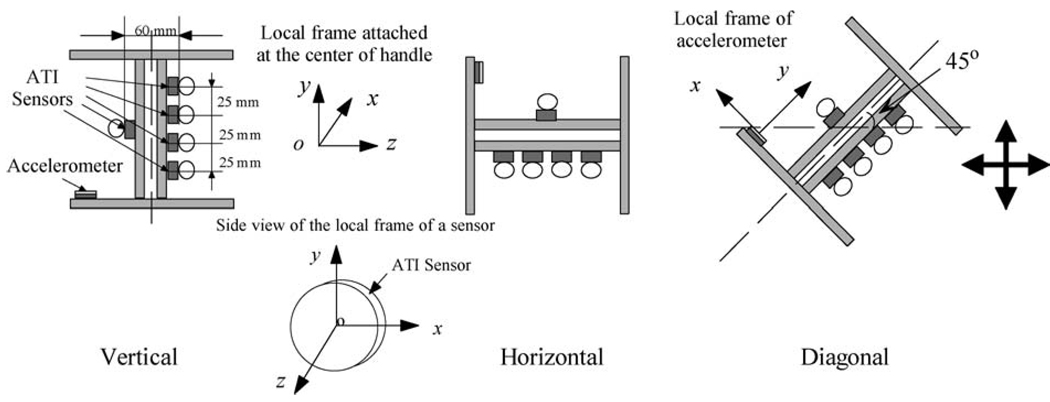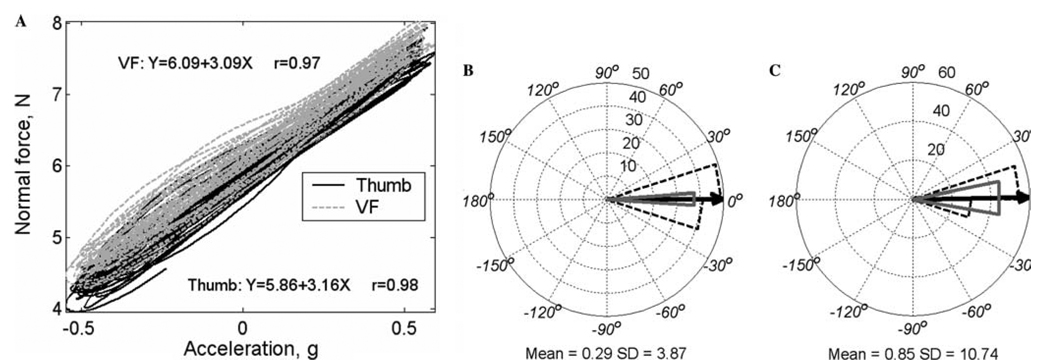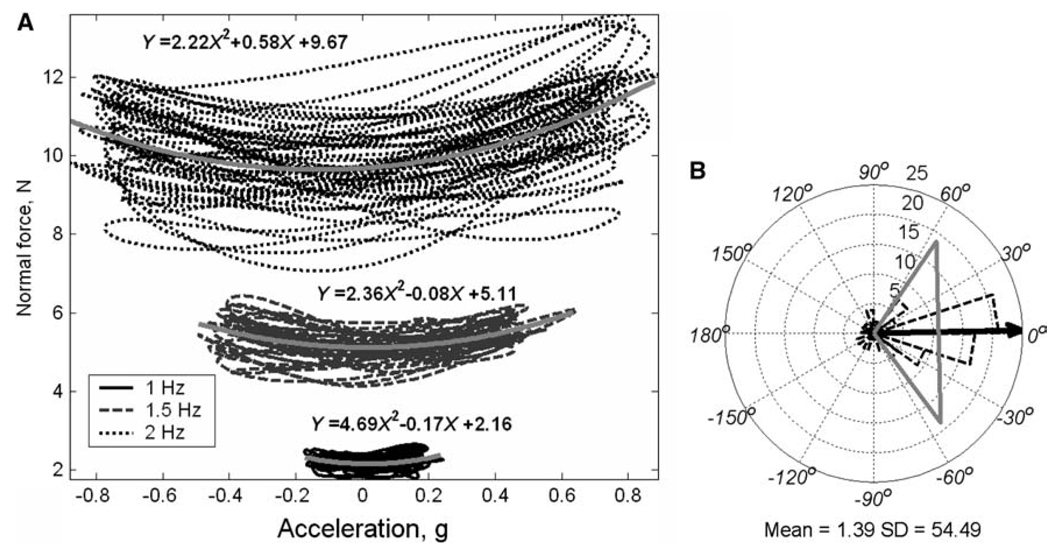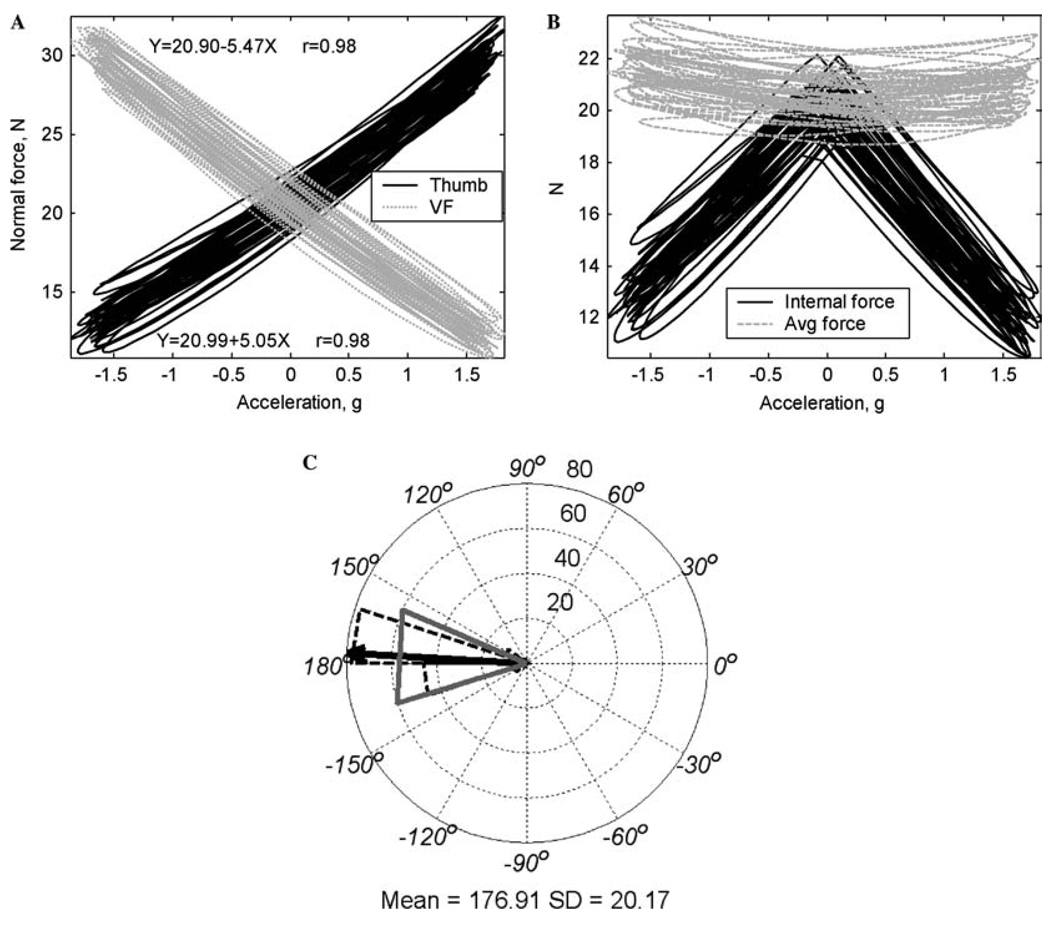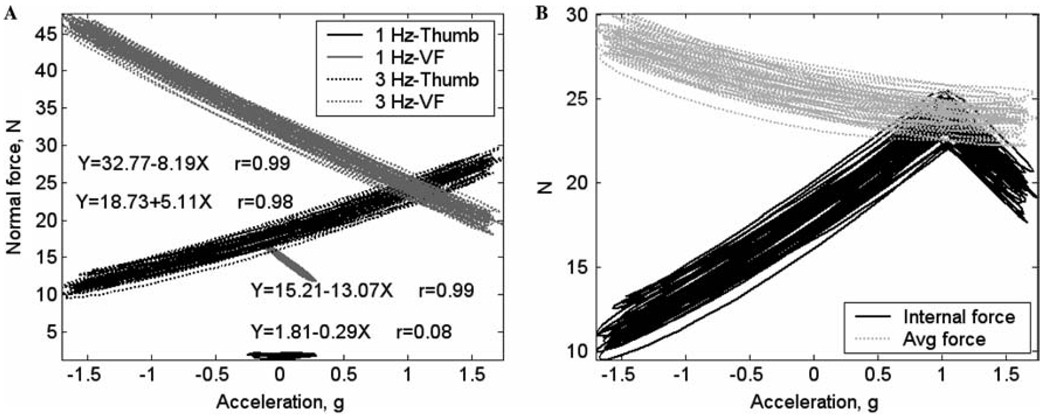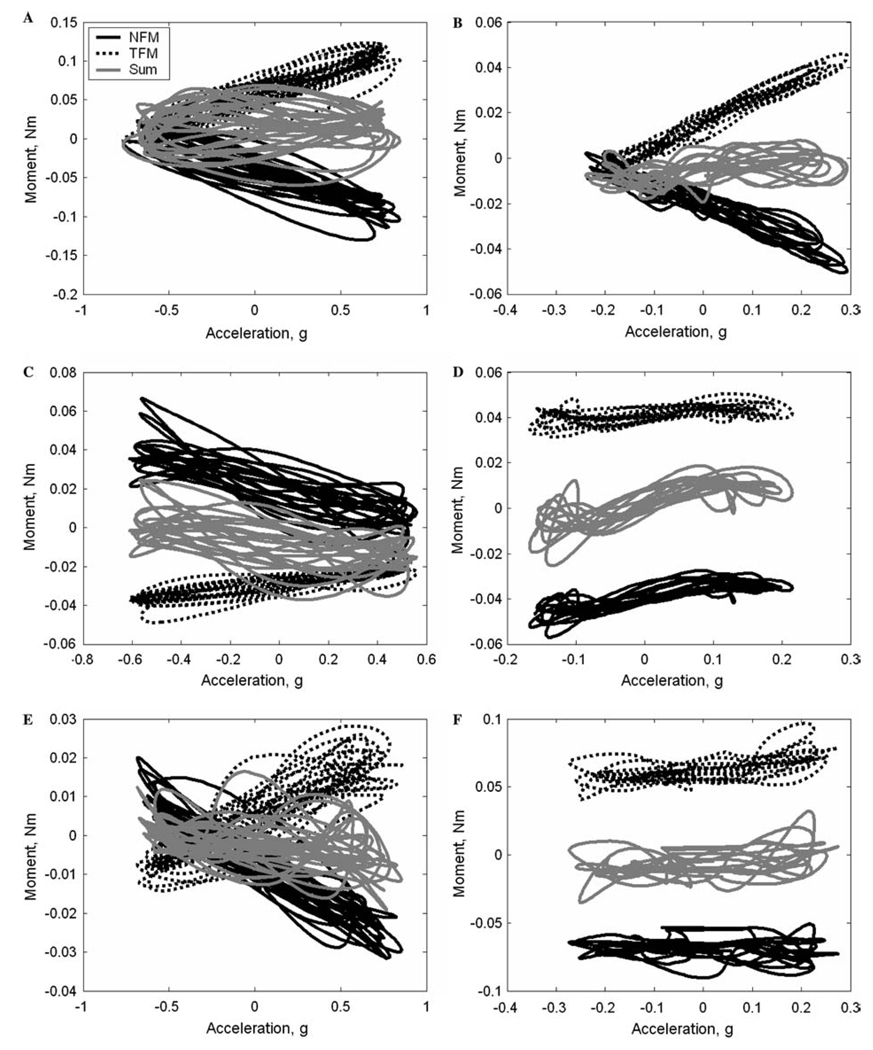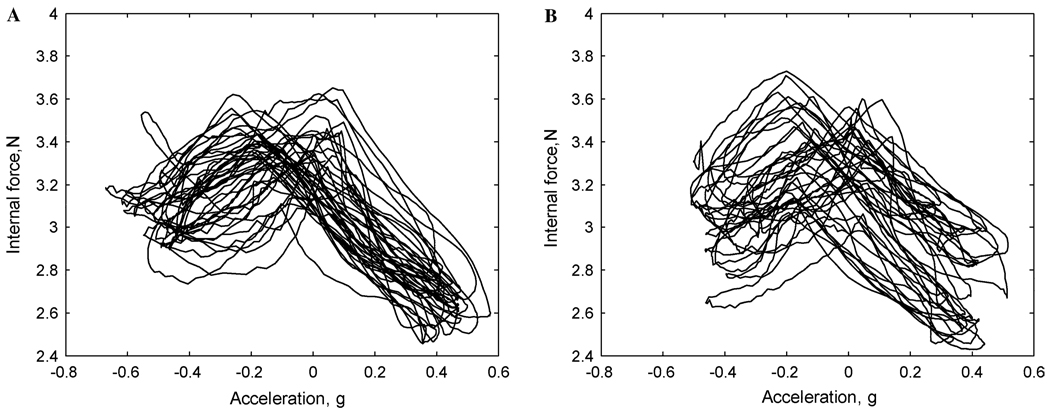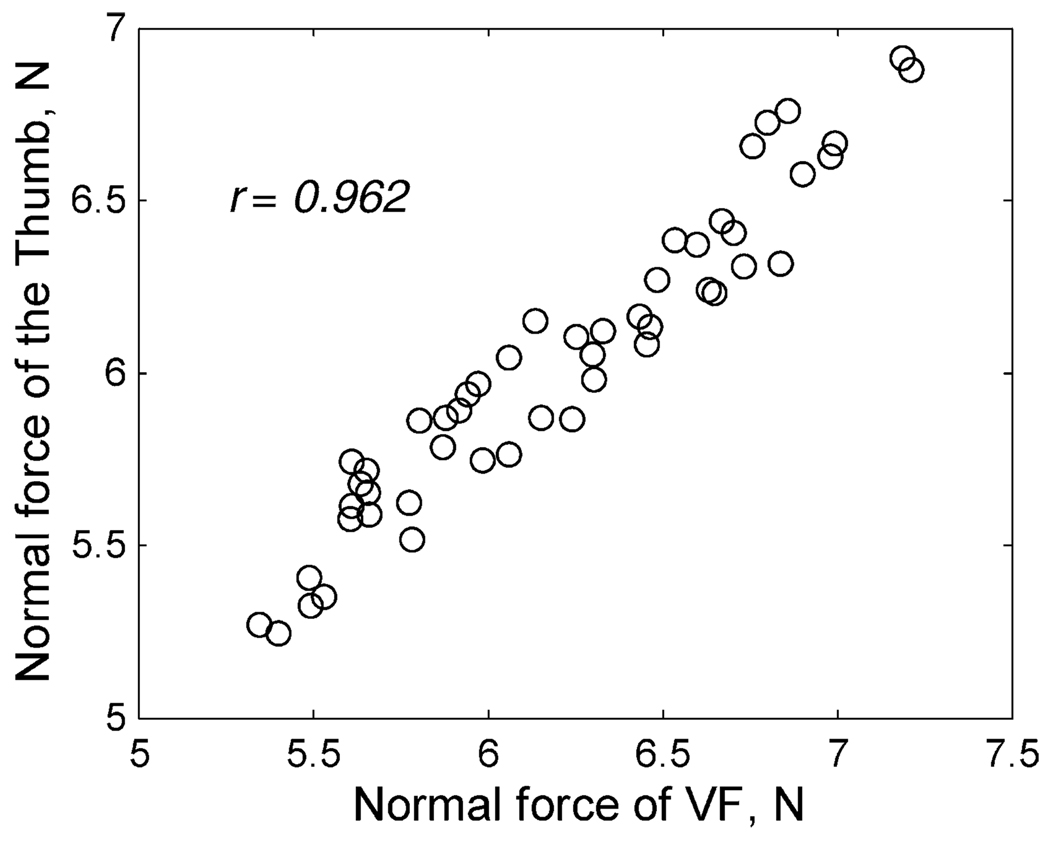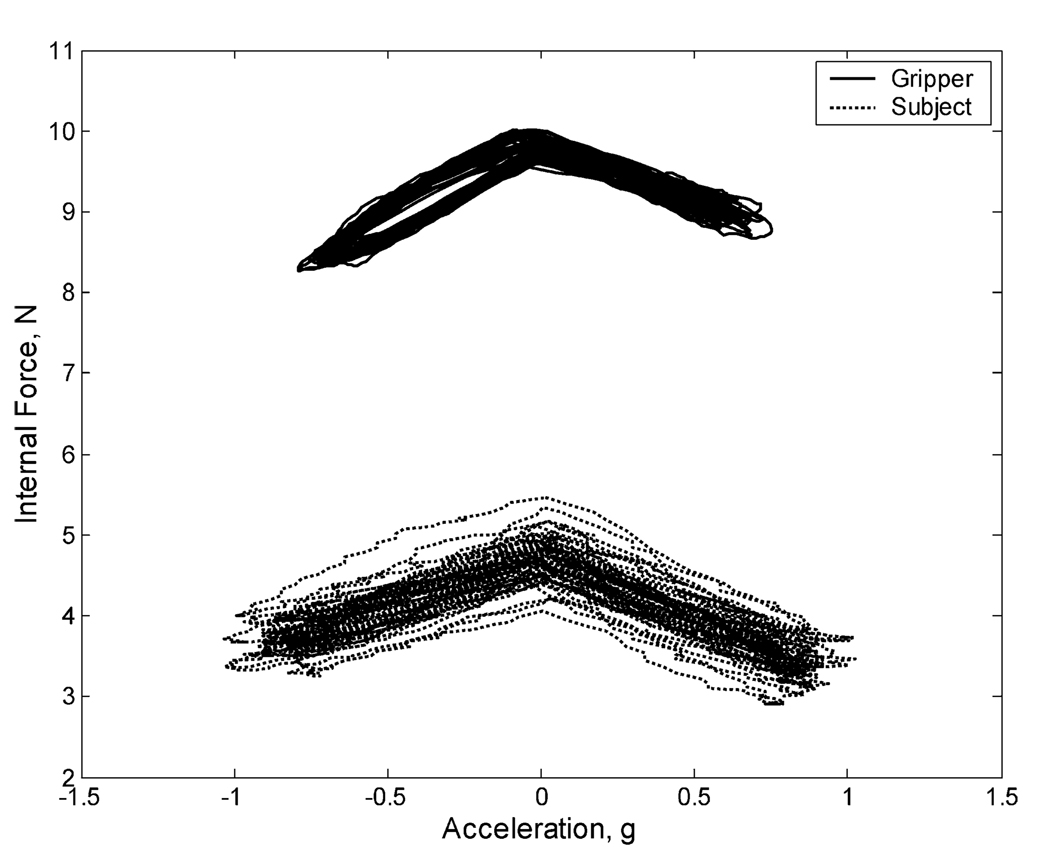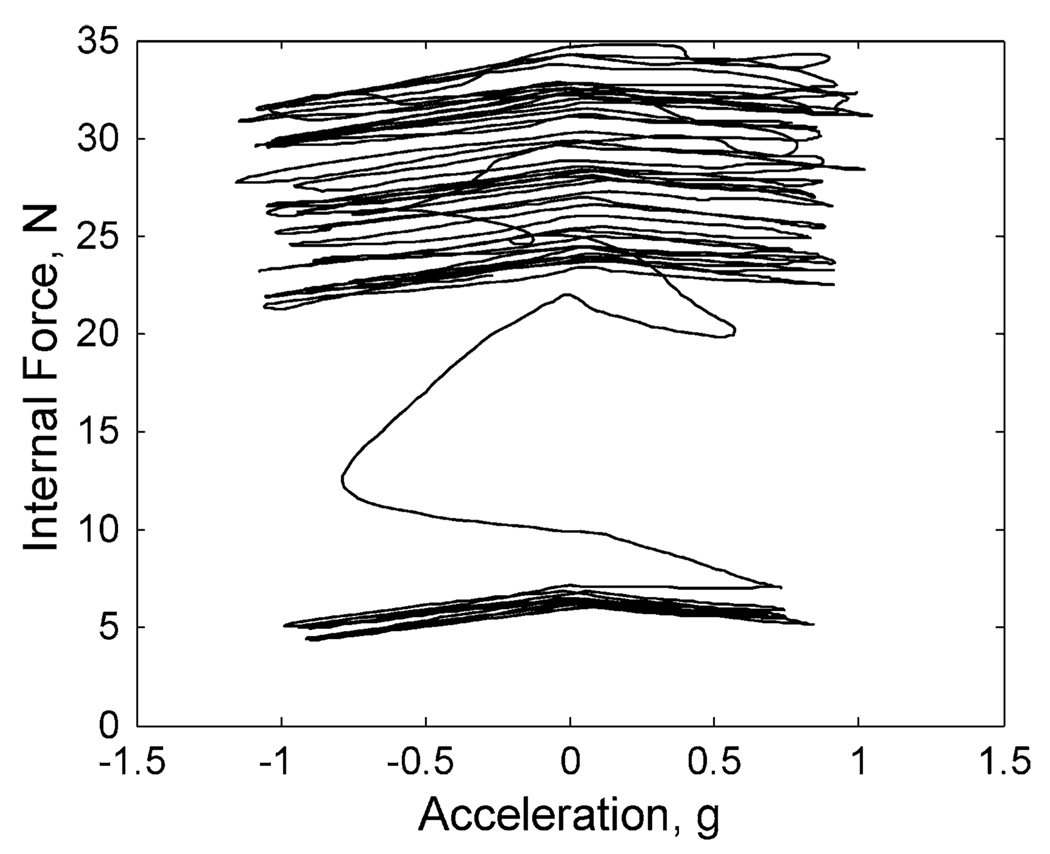Abstract
Internal force is a set of contact forces that does not disturb object equilibrium. The elements of the internal force vector cancel each other and, hence, do not contribute to the resultant (manipulation) force acting on the object. The mathematical independence of the internal and manipulation forces allows for their independent (decoupled) control realized in robotic manipulators. To examine whether in humans internal force is coupled with the manipulation force and what grasping strategy the performers utilize, the subjects (n=6) were instructed to make cyclic arm movements with a customized handle. Six combinations of handle orientation and movement direction were tested. These involved: parallel manipulations (1) VV task (vertical orientation and vertical movement) and (2) HH task (horizontal orientation and horizontal movement); orthogonal manipulations (3) VH task (vertical orientation and horizontal movement) and (4) HV task (horizontal orientation and vertical movement); and diagonal manipulations (5) DV task (diagonal orientation and vertical movement) and (6) DH task (diagonal orientation and horizontal movement). Handle weight (from 3.8 to 13.8 N), and movement frequency (from 1 to 3 Hz) were systematically changed. The analysis was performed at the thumb-virtual finger level (VF, an imaginary finger that produces a wrench equal to the sum of wrenches produced by all the fingers). At this level, the forces of interest could be reduced to the internal force and internal moment. During the parallel manipulations, the internal (grip) force was coupled with the manipulation force (producing object acceleration) and the thumb-VF forces increased or decreased in phase: the thumb and VF worked in synchrony to grasp the object more strongly or more weakly. During the orthogonal manipulations, the thumb-VF forces changed out of phase: the plots of the internal force vs. object acceleration resembled an inverted letter V. The HV task was the only task where the relative phase (coupling) between the normal forces of the thumb and VF depended on oscillation frequency. During the diagonal manipulations, the coupling was different in the DV and DH tasks. A novel observation of substantial internal moments is described: the moments produced by the normal finger forces were counterbalanced by the moments produced by the tangential forces such that the resultant moments were close to zero. Implications of the findings for the notion of grasping synergies are discussed.
Keywords: Internal force, Manipulation force, Prehension, Prehension synergy, Grasping, Fingers
Introduction
In multi-digit grasping, a vector of contact forces and moments f can be broken into two orthogonal vectors: the resultant force vector fr (manipulation force) and the vector of the internal force fi (f=fr + fi) (Kerr and Roth 1986; Yoshikawa and Nagai 1991). Internal force is a set of contact forces, which can be applied to an object without disturbing its equilibrium (Mason and Salisbury 1985; Murray et al. 1994). The elements of the internal force vector fi cancel each other and, hence, do not contribute to the manipulation force. A performer can choose innumerable combinations of the force elements provided that they cancel each other, for instance, the performer can grasp an object more strongly or more weakly.
The mathematical independence of the internal and manipulation forces allows for their independent (decoupled) control. Such a decoupled control is realized in robotic manipulators (e.g. Zuo and Qian 2000). However, people most probably do not use this option: it has been firmly established that when people move a vertically oriented object in the vertical direction the grip force FG increases in parallel with the load force FL (FL = W+ma, where W is the object’s weight, m is its mass and a is acceleration), apparently to prevent slip (Johansson and Westling 1984; Flanagan and Wing 1993, 1995; Flanagan et al. 1993; Flanagan and Tresilian 1994; Nakazawa et al. 1996, 1999; Kinoshita et al. 1996; Gordon et al. 1999; Gysin et al. 2003; see also Flanagan and Johansson 2002 for a recent review). The FG–FL coupling is so strong that people increase FG in parallel with FL even when FG is already much above the slipping threshold, e.g. when before lifting the object a performer purposefully grasps the object with a high force (Flanagan and Wing 1995).
Vertical lifting of a vertically oriented handle is only one of the many examples of object manipulation. In daily life, people commonly manipulate objects in non-vertical directions and with the surfaces of digit contact not parallel to the direction of acceleration. It is unknown whether the internal force-manipulation force coupling exists in such tasks. For instance, do people grasp the hand-held objects (e.g. golf clubs, tennis rackets, etc.) more strongly when the object is being accelerated?
The following terminology is used: virtual finger (VF) is an imaginary finger that produces a wrench (the force and moment) equal to the sum of wrenches produced by all the fingers (Arbib et al. 1985; Cutkosky 1985; Iberall 1987; Iberall et al. 1989; Santello and Soechting 2000; Baud-Bovy and Soechting 2001). The handle orientation is defined as the angle between the longitudinal axis of the handle and the vertical. At the vertical handle orientation, the angle is zero. The direction of manipulation is defined with respect to either vertical or the horizontal axes. When the handle orientation and the direction of manipulation are along the same axis (e.g. a vertically oriented handle is being moved in the vertical direction or a horizontally oriented handle in the horizontal direction) the manipulation is called the parallel manipulation. The orthogonal manipulation corresponds to the object motion at right angles to the handle orientation, e.g. a vertically oriented handle is being moved in a horizontal plane or a horizontally oriented handle is moved in a vertical plane. Grasping synergy (GS) is a conjoint change of the normal digit forces (Zatsiorsky and Latash 2004).
This study addressed the following general problem: how is the internal force–manipulation force coupling— if it exists—affected by such factors as grasp orientation and direction of manipulation? Specifically, we were interested in two questions. First, is the internal force coupled with the manipulation force? To answer this question we analyzed whether the internal forces/moments change conjointly with the handle acceleration (the handle acceleration is representative of the manipulation force acting on the object). Second, do grasping synergies depend on the type and parameters of object manipulation?
Methods
Six male subjects (27±6 years, 75±9 kg) participated voluntarily in this study. Subjects were all right-handed based on their daily usage of the hand and reported no previous history of neuropathies or trauma to the upper extremities. All subjects gave informed consent to comply with the procedures approved by the Office for Research Protection of Pennsylvania State University.
Experimental setup
A customized aluminum handle composed of two horizontal bars and two vertical pillars was used (Fig. 1). Five six-component force/torque transducers (Nano-17, ATI Industrial Automation, Garner, NC, USA) were mounted on the pillars. The center points of the index and middle finger sensors were located 37.5 and 12.5 mm, respectively, above the midpoint of the handle. The center points of the ring and little finger sensors were located 12.5 and 37.5 mm, respectively, below the midpoint. The grip width (the distance between the surfaces of the thumb contact and of the finger contacts) was 60 mm. The surfaces of the transducers were covered with 100-grit sandpaper. In different subjects, the coefficient of friction ranged between 1.4 and 1.5 (measured previously; Gao 2002). A triaxial accelerometer (EGA 3, Entran, USA; range ±5 g, weight 7 g) was mounted on the horizontal bar at the lower left corner to record the acceleration of the handle. The output cables of the sensors were tied together and hung approximately 20 cm above the top of the handle to avoid interference during the movements.
Fig. 1.
Schematic drawing of the handle and three handle orientations. The arrows to the right signify the movement directions. Placement of the sensors including ATI force/torque sensors and EGA accelerometer is shown in the left panel. Note that in the handle frame the local x and z axes for the thumb and fingers are in opposite directions. When the handle was orientated horizontally or diagonally the thumb sensor was always on the top
The output signals of the ATI sensors were fed into a customized box that split the signals to two 32-channel 12-bit AD converters (PCI-6033E; National Instruments, Austin, TX, USA). The signals of the EGA accelerometer were fed into SCXI-1520, a signal-conditioning module (National Instruments) and then into a 12-bit AD converter (PCI-6052E; National Instruments). The digital signals were processed using a computer (Dell Dimension 8200). The sampling frequency was set at 200 Hz and data were recorded by a customized program written in LabView 6.1 (National Instruments).
Test procedure
Before the experiment, subjects cleaned the tips of the digits with alcohol to normalize the skin condition. The subjects were instructed to hold the handle statically with the forearm unsupported while placing the tips of the digits at the centers of the sensors before each trial. For different movement frequencies, an auditory metronome was used to provide a rhythmic beep signal, and the subjects tried to follow the tempo of the signal. The subjects were required to make a whole cycle between two consecutive beeps such that the beeps occurred at extreme points, top or bottom points for vertical movements and leftmost or rightmost points for horizontal movements. On the whole, the subjects followed the metronome well: the group average frequencies were 1.03±0.02, 1.53±0.04, 1.99±0.06, 2.52±0.06 and 3.04±0.13 Hz when the target frequencies were 1.0, 1.5, 2.0, 2.5 and 3.0 Hz, respectively.
Experiment 1: vertical cyclic movements
Subjects were instructed to make vertical cyclic handle movements while timing the movements with the beeps generated by the metronome. Two horizontal strings, 10 cm apart in the vertical direction, were used to mark the target amplitude of the movements.
Experiment 2: horizontal cyclic movements
Subjects were instructed to make horizontal cyclic handle movements while timing the movements with beeps generated by the metronome. Pieces of white tape placed 10 cm apart in the horizontal direction were used to mark the target amplitude of the movements.
Three handle orientations; vertical, horizontal and diagonal (inclined 45°) were used. Hence, six combinations of handle orientation and movement direction were tested. The tasks were designated as follows:
-
Parallel manipulations
-
1a.
VV task: vertical orientation–vertical movement
-
1b.
HH task: horizontal orientation–horizontal movement
-
1a.
-
Orthogonal manipulations
-
2a.
VH task: vertical orientation–horizontal movement
-
2b.
HV task: horizontal orientation–vertical movement
-
2a.
-
Diagonal manipulations
-
3a.
DV task: diagonal orientation–vertical movement
-
3b.
DH task: diagonal orientation–horizontal movement
-
3a.
In each task, five loads were used: 3.8, 6.3, 8.8, 11.3 and 13.8 N (including the weight of the handle with the sensors). When the handle was oriented horizontally or at 45° the loads were symmetrically attached at both sides of the handle. The oscillations were performed at three frequencies, 1.0, 1.5 and 2.0 Hz. In addition, two more frequencies, 2.5 and 3.0 Hz, were tested for the vertical motion of the horizontally oriented handle and for the horizontal motion of the vertically oriented handle. Each subject performed the total of 110 trials (two directions of movement · three handle orientations · five loads · three frequencies) + (two tasks · five loads · two frequencies).
At the amplitude of the harmonic oscillation of 5 cm and the frequencies 1.0, 1.5 and 2.0 Hz, and 2.5 and 3.0 Hz the computed peak values of acceleration were 1.97, 4.44 and 7.89 m/s2, and 12.34 and 17.77 m/s2, respectively (amax = ω2x, whereωis the circular frequency measured in radians per second and x is the amplitude). Note that when the handle was oriented horizontally (or at 45°) and the acceleration exceeded 1 g=9.81 m/s2, the thumb had to generate force to accelerate the handle downward.
Each test lasted 15 s; there was a 20-s break between consecutive trials. At the beginning of the test for each load condition, subjects were asked to hold the handle at rest with minimum effort and the static finger forces were recorded for 15 s. The order of the tests was pseudo-randomized. The subjects were instructed to move the handle along a straight line and to keep its orientation constant throughout the test. The movement of the handle was performed mainly at the elbow and shoulder joints. The movement was visually monitored by the experimenter. Handle rotation and wrist movement were not recorded but based on the visual observations they were assumed small.
Data analysis
The data analysis included: (a) computing the digit forces and moments, (b) determining the internal forces, and (c) phase angle analysis.
Digit forces and moments
Raw data were low-pass filtered at 5 Hz with a fourth-order Butterworth filter. In some trials, low-frequency changes in the normal force were observed. Therefore, a high-pass filter at a cutoff frequency of 3 Hz was applied to the normal force and an offset was added such that the filtered force had the same mean as the unfiltered normal force. The normal and tangential force components were recorded. Acceleration was calculated along the direction of the handle movement. For the diagonal handle orientation the resultant acceleration was calculated as .
The point of application of the VF normal force can displace due to (a) different sharing of the force among the fingers and/or (b) displacements of application points of individual digit forces on the sensors. The y coordinates of digit force applications with respect to the sensor centers were computed as, where represents the moment of the ith digit with respect to the x-axis and represents the normal force of the ith digit. The computed values were then used to compute the moment arms of the digit forces in the handle reference frame.
When the thumb and VF normal forces are not collinear they form a force couple, which generates a moment of the couple. The moment of the VF normal forces about axis was computed about the point of the thumb force application as: where ri represents the moment arm of the normal force of the ith finger with respect to the point of the thumb force application.
Internal forces
In five-digit grasps, the vector of the individual digit forces and moments f is a 30×1 vector. Its relation with a 6×1 vector F of the resultant forces and moments acting on the object is described by −F=Gf, where G is a 6×30 grasp matrix (Salisbury and Craig 1982; Kerr and Roth 1986). The vector of the internal forces fi lies in the null space of G (the null space of a m×n matrix G is the set of all vectors f in Rn such that Gf=0{f ∈ N(G)|Gf =0}). Because the rank of a 6×30 matrix is at most 6, the dimensionality of the null space of the grasp matrix (its nullity) is at least 24. Hence there exist many finger force-moment combinations that interact in such a manner that the individual forces and moments cancel each other and do not contribute to the manipulation force. For instance, if individual tangential finger forces are in opposite directions, ulnar and radial, these force components can annul each other such that the resultant tangential force equals zero. Analysis of all the 24 basic vectors of N(G) would be a daunting task.
We restricted the analysis to the planar case. Only the normal and tangential components of the VF and thumb forces were analyzed. A two-digit pinch grasp with soft finger contacts has been previously studied (Kerr and Roth 1986). In such a grasp two internal forces are recognized. The first internal force corresponds to equal values of the normal components of the digit forces, and the second to equal values of the twisting moments around the axes normal to the surfaces of the contacts. The latter combination cannot however be realized in single-hand grasping: people cannot twist the thumb and the finger(s) in opposite directions (in two-hand grasping with two fingers this option can be realized). Because of that, the twisting moment was neglected in the present study.
To account for the moment generated by the VF-thumb normal forces, a variable coordinate of the point of application of the VF normal force could be used in matrix G. However, such a technique would make the equation −F=Gf non-linear (a variable force would be multiplied by a variable moment arm). To linearize the above equation we used the following experimentally established fact: humans control grasping force and rotational equilibrium of hand-held objects independently— the fG magnitude does not correlate with the moment that the fG generates (Shim et al. 2003; Zatsiorsky and Latash 2004). This pattern of coordination exemplifies the principle of superposition suggested in robotics (Arimoto et al. 2001). Following the principle of superposition for the handle shown in Fig. 1, the equation −F=Gf was written as
| (1) |
where the subscripts n and t refer to the normal and tangential force components, respectively. In Eq. 1 all the elements of matrix G are constant. Note that the two left elements in the last row were set to zero which is equivalent to postulating that the normal forces of the thumb and VF, , do not generate the moment about the x-axis (the forces are collinear). The effect of possible displacement of the VF force coordinate is represented by the moment included in vector f. The nullity of the matrix in Eq. 1 equals two. The orthonormal basis vectors spanning the null space of G are (0.03 0.03 −0.706 0.706 0.042)T and (−0.706 −0.706 −0.030 0.030 0.002)T. (The basis vectors were calculated by using the singular value decomposition with function, null, in Matlab 6.1). All the vectors that can be obtained from the basis vectors by scalar multiplication and vector addition belong to N(G) which is a two-dimensional space. It is more convenient, however, to simplify the analysis.
Matrix G in Eq. 1 can be split into two independent matrices. The first row makes a (1×5) matrix G1 and the last two rows make a (2×5) matrix G2. After deleting zero elements in matrices G1 and G2, their order will decrease to (1×2) and (2×3), respectively. Then, Eq. 1 can be broken into two equations G1ff = 0 and G2fm = 0, where ff and fm are (2×1) and (3×1) vectors, respectively. The orthonormal basis vectors spanning the null spaces of G1 and G2 are (0.7071 0.7071)T and (−0.7065 0.7065 0.0424)T, respectively. The basis vectors satisfy the following equations:
| (2) |
Vectors ff and fm can be multiplied by any real number; Eq. 2 will still be valid. The null space of G1 corresponds to the internal force produced by the normal forces of the thumb and VF. When a grasp is oriented vertically and the object is either at rest or is moved in the vertical direction, the thumb and the opposing fingers exert equal and opposite normal forces that cancel each other. These equal forces represent the grip force FG. In all other cases, the forces are not equal, and the smallest of them represents the internal force. The null space of G2 corresponds to the tangential force production and the moment production about x-axis: the moment
is canceled by the moment of the tangential forces
If the handle is in rotational equilibrium .
If it experiences angular acceleration, the smaller of these two moments represents the internal moment.
Phase angle analysis
While the recorded thumb and VF forces depended on the loads and frequencies (as would be expected from the basic mechanics), we did not analyze these data in detail in the present study, limiting the analysis only to the phase relations between the variables.
Fast Fourier transform (FFT) analysis of the handle acceleration and the digit forces was performed for each data series over each whole test period. The number of points for the FFT was chosen as 218 (64×212, where 212 is the nearest integer that satisfies the condition 212>3000, the total number of data points in one trial). Such a technique allows for a better resolution due to the zero-padding effect (Proakis and Manolakis 1996). The phase angles at which the power spectrum magnitude attains the maximum were defined. The phase differences (relative phase) between the signals were then computed.
The phase angle analyses were done through circular statistics (Batschelet 1981). To test whether the samples are clustered or significantly different from randomness, the Rayleigh test was applied. To further test whether the observed angles have a tendency to cluster around a given angle the V-test (the modified Rayleigh test) was applied. The null hypothesis H0 was that the relative phases are distributed uniformly. In five tasks of six, the null hypothesis H0 was rejected: the relative phases were clustered around either 0° or 180° (Fig. 2a–c). In these tasks, the data on the relative phases were combined over the loads, frequencies and subjects. The only exception was the HV task where the relative phases depended on the frequency (Fig. 2d–f). These data were analyzed separately. Statistical analysis was done in the Statistics toolbox of Matlab 6.1 (The MathWorks, Natick, MA, USA).
Fig. 2.
Relative phase between the normal forces of the thumb and VF at different frequencies (across all subjects and load conditions), circular histograms. Upper panels VH task, bottom panels HV task. Movement frequencies were 1.0, 2.0 and 3.0 Hz; n=30 (six subjects × five loads). In these and other circular histogram, if not stated otherwise: (1) thick black arrow represents the mean phase angles and the gray triangle represents the angular standard deviation, and (2) the dashed lines show the data for individual bins, the bin size is 20°. The positive values of the phase angles in the VH tasks (bottom panels) indicate that the VF force trailed the thumb force
Results
The results are presented in two subsections dealing with the internal force and internal moment, respectively. The sequence in the subsections is: parallel manipulation, orthogonal manipulation, and diagonal manipulation.
Internal force
Parallel manipulation
The parallel manipulation included two tasks: the VV manipulation and the HH manipulation.
VV manipulation
VV manipulation has been extensively studied previously and is included here mainly for comparison. During the VV manipulation the normal forces of the thumb and VF changed in phase with the acceleration (manipulation force). For instance, the phase angle between the VF normal force and the handle acceleration was only 0.29±3.87° (sample mean±SD; Fig. 3a, b); the statistically significant clustering around a zero angle was confirmed with the V-test (i.e. the null hypothesis H0 was rejected; P<0.01). The finding supports the existence of a tight coupling between the internal and manipulation forces reported previously (the FG–FL coupling). The same was true for the thumb and VF normal forces: the mean phase angle was 0.85±10.74° (V-test, P<0.01, Fig. 3c). The coordination pattern characterized by a simultaneous (in phase) increase or decrease of the normal forces of the thumb and VF will be called the symmetric GS. Hence, in the VV task a symmetric GS was used.
Fig. 3.
VV manipulation. a Normal forces of the thumb and VF (N) versus the handle acceleration in the vertical direction. A representative trial, weight (W) 8.8 N, frequency 1.5 Hz, representative subject. With the acceleration from approximately −0.5 to 0.5 g the tangential force L (load) varied from approximately 4.4 to 13.2 N (L=W+ma). The range of the internal force fluctuations was approximately 4.0 N, from 4.0 N to 8.0 N. b The VF normal force– acceleration phase angles (circular histogram). The phase angles cluster around 0°. c The VF normal force–thumb normal force phase angles (circular histogram). In this and other following circular diagrams if not stated otherwise, n=90 (six subjects × five loads × three frequencies). The designations are the same as in Fig. 2
HH manipulation
During HH manipulation, the VF supports the load and the internal force equals the thumb normal force. An important distinction between the parallel manipulation in the vertical and horizontal directions is that during the vertical manipulation the tangential force exerted by the subject—if the downward acceleration of the handle does not exceed 1 g—is always directed upward, while during the horizontal manipulation the tangential force during a cycle changes its direction. The normal forces of the thumb and the VF changed in phase (the mean relative phase is 1.39°, Fig. 4b) and only slightly increased with the acceleration magnitude (Fig. 4a).
Fig. 4.
HH manipulation. a Normal force of the thumb versus the handle acceleration in the horizontal direction. Representative trials, the load was 13.8 N, the frequencies were 1.0, 1.5 and 2.0 Hz, representative subject. The internal force varied less than 2.0 N. b The thumb normal force–VF normal force phase angle (circular histogram)
Orthogonal manipulation
The orthogonal manipulation included two tasks: the VH manipulation and the HV manipulation.
VH manipulation
The normal force of the thumb changed out-of-phase with the VF force (Fig. 5c). The phase angle clustered around 180° (176.91±20.17°; clustering was confirmed by the statistical V-test). The reciprocal changes were also revealed by plotting the normal force with respect to the handle acceleration: as shown in Fig. 5a the normal forces of the thumb and VF changed in opposite directions. We will call such reciprocal thumb force–VF force changes the anti-symmetric GS. Note that this terminology does not imply that the reciprocal force changes are due to the modulation of the efferent signals to the corresponding muscles; they may be due to purely mechanical effects. The internal force demonstrated an ‘inverted V’ pattern with respect to the handle acceleration (Fig. 5b). The maximal values of the internal force corresponded to the instances of zero acceleration and the minimal internal force was exerted when the acceleration magnitude was maximal. The average force was approximately constant regardless of the acceleration magnitude and direction.
Fig. 5.
VH manipulation. a Normal forces of the thumb and VF versus the handle acceleration in the horizontal direction. A representative trial, the load was 11.3 N, the frequency was 3 Hz, representative subject no. 1. b Internal force and average normal force versus the handle acceleration. The range of the internal force fluctuations was approximately 8.0 N, from 12.0 to 21.0 N. c The thumb normal force–VF normal force phase angle [circular histogram, n=150 (six subjects × five loads × five frequencies)]
HV manipulation
This was the only manipulation where the relative phases depended on frequency (see Figs. 2d–f, and Fig. 6). At low frequencies, e.g. 1 Hz, the thumb force—which is an internal force in this task—did not change much during the performance (Fig. 6a). The relative phase of the thumb–VF forces varied substantially; at 1 Hz it was on average 66.99° and the standard deviation was 72.62° (Fig. 2d). With an increase in the frequency, the phase angle increased and its standard deviation decreased; the phase angle was 124.53±53.31° at a frequency of 1.5 Hz, 152.13±52.6° at 2.0 Hz, 161.09±15.79° at 2.5 Hz, and 165.30±15.34° at 3.0 Hz. Hence, at higher frequencies, the normal force of the thumb changed approximately out of phase with respect to that of the VF (and slightly ahead of it). The anti-symmetric GS was also revealed by plotting the thumb and VF normal forces with respect to the handle acceleration: the forces change in opposite directions (Fig. 6a). At the high oscillation frequencies when maximal values of acceleration exceeded 1 g, the VF and thumb normal force–acceleration curves intercepted at the acceleration level of 1 g; as a result, the internal force–acceleration relation had an ‘inverted V’ shape with a peak at 1 g (Fig. 6b).
Fig. 6.
HV manipulation. a Normal forces of the thumb and VF versus the handle acceleration in the vertical direction. Two representative trials, the load was 13.8 N, the frequencies were 1 and 3 Hz, representative subject. b Internal force and average normal force versus the handle acceleration. Frequency was 3 Hz. The internal force changed from approximately 10.0 to 24.0 N
Diagonal manipulation
The diagonal manipulation included two tasks: the DV manipulation and the DH manipulation. During such manipulations, the VF supports the load and the internal force equals the thumb normal force.
DV manipulation
The normal forces of the thumb and VF positively correlated with the handle acceleration (resultant force) in the vertical direction (Fig. 7a). The normal force of the thumb changed in-phase with that of the VF; the mean phase angle was −1.03° (Fig. 7b). Hence, the symmetric GS was used. The normal forces of the thumb also changed in-phase with the handle acceleration (Fig. 7c). Both in-phase changes were confirmed by the V-test (P<0.01).
Fig. 7.
DV manipulation. a Normal forces of the thumb and VF versus the handle acceleration in the vertical direction. A representative trial, the load was 13.8 N, the frequency was 2 Hz, representative subject. Note that when the handle acceleration is negative (directed downward) the vertical component of the resultant force exerted on the handle is still positive. The internal force fluctuation was small, below 2.0 N. b The phase angles between the normal force of the thumb and VF (circular histogram). c The phase angles between the thumb normal force (the internal force) and the handle acceleration (circular histogram)
DH manipulation
The normal forces of the thumb and VF changed in anti-phase with each other (anti-symmetric GS) (Fig. 8a, c). This may be explained by the task mechanics: when the handle was accelerated to the right (positive values of acceleration) the manipulation force was provided by the thumb while the leftward acceleration was due to the VF force. In this regard the task was similar to the VH task. The thumb normal force changes were coupled with the handle acceleration (Fig. 8b). However, we cannot claim that the changes were in anti-phase, because this conclusion depends on the selected direction of the coordinate axes. If the positive direction were selected to the left, the phase angles would be around zero degrees (in-phase).
Fig. 8.
DH manipulation. a Normal forces of the thumb and VF versus the handle acceleration in the horizontal direction. A representative trial, the load was 13.8 N, the frequency was 2 Hz, representative subject. The range of the internal force fluctuations was approximately 7.0 N, from 10.0 to 17.0 N. b The phase angles between the normal force of the thumb and the handle acceleration (circular histogram). Note that this graph is only valid for the selected direction of the coordinate axes. c The thumb normal force–VF normal force phase angle (circular histogram)
The results for all the six tasks are summarized in Table 1
Table 1.
Summary of the results
| Manipulation | Coupling of the thumb and VF normal forces (grasping synergies) |
Internal force–manipulation force (acceleration) coupling |
|---|---|---|
| Parallel | ||
| VV | Symmetric | Positive |
| HH | Symmetric | Positive (the internal force increases slightly with the acceleration magnitude) |
| Orthogonal | ||
| VH | Anti-symmetric | Inverted-V pattern (symmetric) |
| HV | Depends on the frequency. | Depends on the frequency. |
| Approximately anti-symmetric at high frequencies |
At high frequencies an asymmetric inverted-V pattern with the peak at 1 g |
|
| Diagonal | ||
| DV | Symmetric | Positive |
| DH | Anti-symmetric | Positive (for the selected direction of the coordinate axes) |
Internal moment
Internal moments—i.e. the moments of the tangential forces and the normal VF forces—were small (below 0.05 Nm, with the exception of the VV manipulation where they were up to 0.11 Nm). However, the internal moments were always present and their changes in a trial showed a strong negative correlation; as expected they cancelled each other (Fig. 9). During the VH and DH manipulations (Fig. 9d, f), the moments did not change substantially with the handle acceleration, while in the other four cases they were coupled with the acceleration, and hence coupled with the manipulation force.
Fig. 9.
Representative examples of internal and resultant moments in various tasks. NFM moment of normal force, TFM moment of tangential force, Sum (NFM + TFM)=resultant moment. a VV: 2 Hz, 13.8 N, representative subject. b HH: 1 Hz, 6.3 N, representative subject. c HV: 1.5 Hz, 8.8 N, representative subject. d VH: 1 Hz, 8.8 N, representative subject. e DV: 2 Hz, 3.8 N, representative subject. f DH: 1 Hz, 8.8 N, representative subject
Discussion
Internal forces do not affect equations of motion (Murray et al. 1994) and hence control of manipulation can be broken up into two subtasks—‘holding’ and ‘tracking’—which can be controlled independently. For instance, the performers in our tests could grasp the object with a large force and then keep this force constant during the performance. Such a control strategy (which is commonly used in robotic grippers—Zuo and Qian 2000) simplifies the control—the controller does not have to bother about on-line adjustments of the grip force to the object acceleration and/or orientation. This strategy requires, however, exerting unnecessarily large forces and is in this sense uneconomical. Available data suggest that at least in some tasks the CNS prefers to face larger computational costs rather than produce excessive forces.
Parallel tasks and symmetric GSs
The symmetric GSs have been observed in the parallel tasks, VV and HH, as well as in the DV task (Fig. 3, Fig 4 and Fig 7). In the first two tasks the manipulation force is a tangential force and in the DV task the tangential component is large due to the contribution of the object weight. The FG–FL force coupling during lifting or oscillating a vertically oriented handle (the VV task) has been well documented in previous studies (Flanagan and Tresilian 1994; Flanagan and Wing 1993, 1995; Kinoshita et al. 1996): FG and FL change in parallel. A common interpretation has been that the CNS increases FG in-phase with the rise of FL in order to prevent the slipping of the object out of the hand. Note, however, that this control strategy is not necessitated by the task mechanics: other strategies could work equally well provided that FG is large enough to prevent slipping. In the HH task the increase of the FG with the acceleration magnitude was only slightly manifested (Fig. 4a), which may be explained by the small acceleration (and hence tangential force) values.
Orthogonal tasks and the reciprocal force changes
The reciprocal changes of the thumb and VF normal forces have been observed in the orthogonal tasks, VH and HV, as well as in the DH task. In the first two tasks the manipulation force is the resultant normal force. During the VH task, when the normal force of the VF/thumb was increasing, the normal force of the opposing digit(s)—which is an internal force in this case—was decreasing by approximately the same amount, such that the average force stayed approximately constant (Fig. 5b). Comparable reciprocal changes of the normal forces during a VH task were previously briefly mentioned by Kinoshita et al. (1996). However, the control of a similar movement when using two hands is different (Reinkensmeyer et al. 1992).
While the kinematics of the single-hand and two-hand VH manipulations are analogous, the dynamics are quite different: during the two-hand manipulation, one hand accelerates not only the load but also the other hand, while the other hand slows down the hand–load– hand system. As a result, the hands squeeze the load with a large force during the movement, i.e. the internal force increases. Theoretically, such coordination is possible in single-hand manipulation. However, in contrast with the two-hand manipulation during the single-hand VH manipulation the internal force decreases when the acceleration increases and attains its maximum at the instant of zero acceleration (and hence at the instant of maximal velocity; the inverted-V pattern, see Fig. 5b). This result is in agreement with the recent data reported by Smith and Soechting (2005). In their experiment, the subjects held an instrumented object in a tripod grasp and moved it in the horizontal plane in various directions (distance 40 cm, movement duration 500 ms). The grasping forces increased during the movement, reaching a peak near the time of peak velocity.
We found that the reciprocal pattern of the VF and thumb forces was very robust: when subjects were instructed to maintain the grip force constant they were unable to do this even with visual feedback (Fig. 10).
Fig. 10.
The internal (‘grip’) forces during the VH manipulation under the instruction to maintain the grip force constant, with (a) and without (b) visual feedback. Representative examples, the load was 3.8 N, the frequency was 1.5 Hz, representative subject. Note the similarity of the patterns with those in Fig. 5b. The range of the internal force fluctuations is approximately 1.0 N, cf. Fig. 5
While the systematic changes of the manipulation force are mechanically necessary the mechanisms of the internal force changes are less evident. We view the internal force changes as a result of superposition of (1) ‘static’ grip force and (2) its modulation during the movement due to (a) mechanical effects and (b) muscle activation changes. The discussion that follows is accompanied by figures that are intended to illustrate the main ideas rather than serve as a proof of their validity.
To measure the ‘static’ FG during the motion we analyzed the digit forces at the instances when the handle acceleration was zero during a trial. The conclusion is that the FG does not stay constant; it varies from cycle to cycle (Fig. 11). The range of the cycle-to-cycle fluctuations was approximately 25% of the average force.
Fig. 11.
Normal forces of the thumb and VF measured at the instances when the handle acceleration equaled zero. A representative example. VH manipulation; frequency 2.5 Hz, load 3.8 N. The range of cycle-to-cycle force variation is approximately 1.5 N
The modulation of the internal force can be (1) a pure mechanical phenomenon, or (2) induced by the central controller. Most probably it emerges from the combination of these two mechanisms. The contribution of the elastic properties of the gripper (hand) can be proven with a simple experiment: when the handle was grasped by a rigid mechanical gripper with elastic tips, the pattern of the FG modulations was similar to those obtained from the human hands (Fig. 12). Hence, changes in the neural control of digit force are not necessary to obtain the ‘inverted V’ pattern of the internal force.
Fig. 12.
Internal forces during the VH manipulation (2 Hz, load 3.8 N.). Representative examples. While the ‘static’ grip force was larger with the gripper, the patterns of the internal force modulations were similar. However, the range of the internal force modulation was larger when the hand was grasped by the hand (approximately 2.5 N) than by the gripper (approximately 1.5 N)
This finding, however, does not discard the possibility that humans activate the involved muscles reciprocally. Such a reciprocal activation of the finger flexor and extensor muscles can be intentional or it can be a byproduct of the entire activation pattern. For instance, fast elbow movements are accompanied by the activation of the wrist flexors and extensors (to prevent the ‘flapping’ of the hand—Latash et al. 1995) and because the extrinsic finger muscles cross the wrist such an activation of the wrist muscles may induce changes in the fingertip forces (Werremeyer and Cole 1997). The reciprocal activation of the finger flexors and extensors cannot be confirmed or discarded without EMG recordings. We are planning to perform these experiments in the near future.
Mechanically, the internal force modulations depend on the mass of the moving object and its acceleration, stiffness of the digit pads (at forces exceeding 4 N the stiffness pads are completely compressed and hence do contribute to the force modulations—Serina et al. 1997) and apparent stiffness of the digit joints, as well as on some other mechanical variables, such as for instance the ‘static’ grip force: when the subjects were asked to grasp the handle as hard as possible and then move it, the modulations of the FG in a cycle associated with the handle acceleration were much smaller than the cycle-to-cycle variation of the FG (i.e. the inter-cycle variability was much larger than the intra-cycle changes, Fig. 13). Hence, depending on the task, the contribution of the pure mechanical factors versus the centrally controlled adjustments of the digit forces may vary. This issue deserves future research.
Fig. 13.
Internal force during oscillation of the handle with a regular grasp (low traces) and a high force grasp (upper traces). The subject was instructed to grasp the handle with minimal force and then increase the force to maximal. An example, VH task; frequency 2 Hz, load 3.8 N. The range of the internal force fluctuations was approximately 2.0 N in both tasks
During the HV task, the manipulation force is directed vertically; it has an anti-gravity and an inertial component. At the low oscillation frequency, the inertial fraction is smaller than the handle weight. For instance, at the oscillating frequency of 1 Hz and oscillation amplitude of 0.05 m the peak acceleration is only 1.97 m/s2 (<1 g). For downward motion, such acceleration can be achieved due solely to gravity force without exerting the thumb force (Fig. 6a; data for 1-Hz oscillation). However, when the frequency and acceleration values increased (e.g. at 3 Hz the peak acceleration is 17.77 m/s2, >1 g) the reciprocal pattern of digit force coordination (the anti-symmetric GS) was observed with the peak internal force at exactly 1 g. Overall, the anti-symmetric GS is typical of the HV task (Fig. 6).
During the DH task, an anti-symmetric GS was observed: When the thumb or VF exerted a force opposite to the acceleration direction, the force magnitude decreased during the movement. The dissimilarity of the DH and DV manipulations (cf. Fig. 7 and Fig 8) is evidently due to the different direction of the acceleration with respect to the gravity force.
On the relation between the internal and manipulation forces
The internal force is defined via the null space of the grasp matrix; it is a basic fact in linear algebra that the null space of a matrix is orthogonal to its rank space (see any textbook on linear algebra). Hence, it should be expected that the internal force and the manipulation force are independent of each other. The internal forces determined in this study do not influence the manipulation force: People can grasp an object more strongly or more weakly or they can generate a larger moment of the tangential forces that is compensated by the moment of the normal forces—such actions do not change the object acceleration or rotational equilibrium. However (see Fig. 5, Fig 8, Fig 10, Fig 12 and Fig 13), it is evident that, at least during the orthogonal manipulation, the manipulation forces affect the internal forces. This fact creates an impression that, in contradiction to the incontestable mathematics, the internal forces and manipulation forces are not independent. Such an apparent controversy deserves an explanation. The null space of the grasp matrix (its basis vectors) depends only on the matrix itself, i.e. on the grasp geometry, and hence it does not depend on the handle manipulation—its direction, speed, handle orientation etc. However, the vector of the individual finger forces and moments f depends on it. During the manipulation, the vector f is different at each instant and hence the values of the manipulation force vector fm and the internal force vector fi can also change.
On the internal (grasping) force
To summarize the results on the internal force during the object manipulation, we conclude that the CNS uses different patterns of the thumb–VF coordination when the manipulation force is in a tangential direction as compared with the manipulation in the normal direction. When the manipulation force is in a tangential direction, the symmetric pattern of the thumb–VF coordination is used: The thumb and VF work in synchrony to grasp the object more strongly or more weakly. In contrast, when the manipulation force is in the normal direction the anti-symmetric force changes are recorded: when the normal force of either thumb or VF increases, the force exerted by the opposing digits decreases.
In the explanation of the mechanisms of the FG–FL coupling, a large role is assigned to the interaction between the perception and action (Johansson and Westling 1984, 1988; Flanagan et al. 1995; Johansson 1998; Wiesendanger and Serrien 2001; for a review see also Flanagan and Johansson 2002). We put forward a hypothesis that sensing large tangential forces at the digit tips induces the symmetric GS that results in increased FG force, while sensing large normal forces from either the thumb or the VF results in the anti-symmetric force production pattern, it decreases the force exerted by the opposing digit(s). Such a force pattern is likely to result from both mechanical and neural mechanisms.
Several studies have shown no time delays between adjustments in the load and grip forces or even anticipatory adjustments in the grip force during manipulation of hand-held objects (Johansson and Westling 1988; Scholz and Latash 1998). These observations argue against a major role of sensory feedback in the GSs and suggest that they are based on feed-forward adjustments in the two forces. However, during cyclic actions, as in the current study, it is possible that sensory information plays a major role at the initiation of the action, and then the control of the GS switches from mostly feedback to mostly feed-forward.
Internal moments
The existence of the internal moments during the object manipulation has not been reported previously. Mechanically, for the handle to be in rotational equilibrium the torques produced by normal force
and tangential force Mt (x) should cancel each other (Zatsiorsky et al. 2002a, b, 2003; Shim et al. 2003; Zatsiorsky and Latash 2004) and hence the observed negative correlation between them seems to reflect this torque constraints (Fig. 9). However, the very production of the internal moments and their systematic changes with the manipulation force (handle acceleration) observed in the four tasks of six elude simple mechanical explanation. In particular, it may be due to the complexity of muscle action owing to anatomical factors such that the prod uction of forces is always associated with the production of moments.
The relatively low magnitudes of the internal moments resulted from covaried changes in the contributions to these moments from the tangential and normal forces (Fig. 9). Covariation between the contributions of the normal and tangential forces to the total moment produced on a hand-held object in statics was observed in an earlier study (Shim et al. 2004). It has been interpreted as resulting from a particular control strategy, a synergy that stabilized a required value or time profile of the total moment. This interpretation has been supported, in particular, by the observed lower covariation in elderly persons as compared to young persons (Shim et al. 2004). Keeping the internal moment low may be viewed as another component of the GS.
At the end, we have to acknowledge several delimitations of the present study: (1) the lack of EMG analysis, (2) illustrative rather than convincing nature of some of the illustrations, (3) limited ranges of loads and frequencies of motion, and (4) analysis of only self-induced motions. We plan to resolve these delimitations in future studies.
Acknowledgements
This study was supported in part by NIH grants AR-048563, AG-018751, and NS-35032. The authors are also thankful to Dr. F. Valero-Cuevas and other participants of the Machines and Organisms Seminar (Cornell University) for useful discussion.
References
- Arbib MA, Iberall T, Lyons D. Coordinated control programs for movements of the hand. Exp Brain Res Suppl. 1985;10:111–129. [Google Scholar]
- Arimoto S, Tahara K, Yamaguchi M, Nguyen PTA, Han M-Y. Principles of superposition for controlling pinch motions by means of robot fingers with soft tips. Robotica. 2001;19:21–28. [Google Scholar]
- Batschelet E. Circular statistics in biology. London New York Toronto Sydney San Francisco: Academic Press; 1981. [Google Scholar]
- Baud-Bovy G, Soechting JF. Two virtual fingers in the control of the tripod grasp. J Neurophysiol. 2001;86:604–615. doi: 10.1152/jn.2001.86.2.604. [DOI] [PubMed] [Google Scholar]
- Cutkosky MR. Robotic grasping and fine manipulation. Boston Dordrecht Lancaster: Kluwer Academic Publishers; 1985. [Google Scholar]
- Flanagan B, Johansson RS. Hand movements. In: Ramashandran V, editor. Encyclopedia of the human brain. vol 2. San Deigo: Academic Press; 2002. pp. 399–414. [Google Scholar]
- Flanagan JR, Tresilian JR. Grip-load force coupling: a general control strategy for transporting objects. J Exp Psychol Hum Percept Perform. 1994;20:944–957. doi: 10.1037//0096-1523.20.5.944. [DOI] [PubMed] [Google Scholar]
- Flanagan JR, Wing AM. Modulation of grip force with load force during point-to-point arm movements. Exp Brain Res. 1993;95:131–143. doi: 10.1007/BF00229662. [DOI] [PubMed] [Google Scholar]
- Flanagan JR, Wing AM. The stability of precision grip forces during cyclic arm movements with a hand-held load. Exp Brain Res. 1995;105:455–464. doi: 10.1007/BF00233045. [DOI] [PubMed] [Google Scholar]
- Flanagan JR, Tresilian J, Wing AM. Coupling of grip force and load force during arm movements with grasped objects. Neurosci Lett. 1993;152:53–56. doi: 10.1016/0304-3940(93)90481-y. [DOI] [PubMed] [Google Scholar]
- Flanagan JR, Wing AM, Allison S, Spenceley A. Effects of surface texture on weight perception when lifting objects with a precision grip. Percept Psychophys. 1995;57:282–290. doi: 10.3758/bf03213054. [DOI] [PubMed] [Google Scholar]
- Gao F. Unpublished Master Thesis. The Pennsylvania State University: Department of Kinesiology; 2002. Coordination of multi-finger prehension. [Google Scholar]
- Gordon AM, Charles J, Duff SV. Fingertip forces during object manipulation in children with hemiplegic cerebral palsy. II: bilateral coordination. Dev Med Child Neurol. 1999;41:176–185. doi: 10.1017/s0012162299000365. [DOI] [PubMed] [Google Scholar]
- Gysin P, Kaminski TR, Gordon AM. Coordination of fingertip forces in object transport during locomotion. Exp Brain Res. 2003;149:371–379. doi: 10.1007/s00221-003-1380-1. [DOI] [PubMed] [Google Scholar]
- Iberall T. IEEE International Conference on Robotics and Automation. vol 4. Raleigh, NC: 1987. The nature of human prehension: three dextrous hands in one; pp. 396–401. [Google Scholar]
- Iberall T, Preti M, Zemke R. Task influence on timing and grasp patterns in human prehension. Soc Neurosci Abstr. 1989;15:397. [Google Scholar]
- Johansson RS. Sensory input and control of grip. Novartis Found Symp. 1998;218:45–59. doi: 10.1002/9780470515563.ch4. [DOI] [PubMed] [Google Scholar]
- Johansson RS, Westling G. Roles of glabrous skin receptors and sensorimotor memory in automatic control of precision grip when lifting rougher or more slippery objects. Exp Brain Res. 1984;56:550–564. doi: 10.1007/BF00237997. [DOI] [PubMed] [Google Scholar]
- Johansson RS, Westling G. Programmed and triggered actions to rapid load changes during precision grip. Exp Brain Res. 1988;71:72–86. doi: 10.1007/BF00247523. [DOI] [PubMed] [Google Scholar]
- Kerr J, Roth B. Analysis of multifingered hands. Int J Rob Res. 1986;4:3–17. [Google Scholar]
- Kinoshita H, Kawai S, Ikuta K, Teraoka T. Individual finger forces acting on a grasped object during shaking actions. Ergonomics. 1996;39:243–256. doi: 10.1080/00140139608964455. [DOI] [PubMed] [Google Scholar]
- Latash ML, Aruin AS, Shapiro MB. The relation between posture and movement: a study of a simple synergy in a two-joint task. Hum Mov Sci. 1995;14:79–107. [Google Scholar]
- Mason MT, Salisbury JK. Robot hands and the mechanics of manipulation. Cambridge MA: MIT Press; 1985. [Google Scholar]
- Murray RM, Li Z, Sastry SS. A mathematical introduction to robotic manipulation. Boca Raton: CRC Press; 1994. [Google Scholar]
- Nakazawa N, Uekita Y, Inooka H, Ikeura R. Experimental study on human’s grasping force. 5th IEEE International Workshop on Robot and Human Communication; 1996. pp. 280–285. [Google Scholar]
- Nakazawa N, Kim I-H, Inooka H, Ikeura R. Force control of a robot hand emulating human’s grasping motion. 1999 IEEE International Conference on Systems, Man, and Cybernetics; 1999. pp. 774–779. [Google Scholar]
- Proakis JG, Manolakis DG. Digital signal processing: principles, algorithms, and applications. Upper Saddle River New Jersey: Prentice-Hall; 1996. [Google Scholar]
- Reinkensmeyer DJ, Lum PS, Lehman SL. Human control of a simple two-hand grasp. Biol Cybern. 1992;67:553–564. doi: 10.1007/BF00198762. [DOI] [PubMed] [Google Scholar]
- Salisbury JK, Craig JJ. Articulated hands: force control and kinematic issues. Int J Rob Res. 1982;1:4–17. [Google Scholar]
- Santello M, Soechting JF. Force synergies for multifingered grasping. Exp Brain Res. 2000;133:457–467. doi: 10.1007/s002210000420. [DOI] [PubMed] [Google Scholar]
- Scholz JP, Latash ML. A study of a bimanual synergy associated with holding an object. Hum Mov Sci. 1998;17:753–779. [Google Scholar]
- Serina ER, Mote CD, Jr, Rempel D. Force response of the fingertip pulp to repeated compression—effects of loading rate, loading angle and anthropometry. J Biomech. 1997;30:1035–1040. doi: 10.1016/s0021-9290(97)00065-1. [DOI] [PubMed] [Google Scholar]
- Shim JK, Latash ML, Zatsiorsky VM. Prehension synergies: trial-to-trial variability and hierarchical organization of stable performance. Exp Brain Res. 2003;152:173–184. doi: 10.1007/s00221-003-1527-0. [DOI] [PMC free article] [PubMed] [Google Scholar]
- Shim JK, Lay BS, Zatsiorsky VM, Latash ML. Age-related changes in finger coordination in static prehension tasks. J Appl Physiol. 2004;97:213–224. doi: 10.1152/japplphysiol.00045.2004. [DOI] [PMC free article] [PubMed] [Google Scholar]
- Smith MA, Soechting JF. Modulation of grasping forces during object transport. J Neurophysiol. 2005;93:137–145. doi: 10.1152/jn.00775.2004. [DOI] [PubMed] [Google Scholar]
- Werremeyer MM, Cole KJ. Wrist action affects precision grip force. J Neurophysiol. 1997;78:271–280. doi: 10.1152/jn.1997.78.1.271. [DOI] [PubMed] [Google Scholar]
- Wiesendanger M, Serrien DJ. Toward a physiological understanding of human dexterity. News Physiol Sci. 2001;16:228–233. doi: 10.1152/physiologyonline.2001.16.5.228. [DOI] [PubMed] [Google Scholar]
- Yoshikawa T, Nagai K. Manipulating and grasping forces in manipulation by multifingered robot hands. IEEE Trans Rob Autom. 1991;7:67–77. [Google Scholar]
- Zatsiorsky V, Latash M. Prehension synergies. Exerc Sport Sci Rev. 2004;32:75–80. doi: 10.1097/00003677-200404000-00007. [DOI] [PMC free article] [PubMed] [Google Scholar]
- Zatsiorsky VM, Gregory RW, Latash ML. Force and torque production in static multifinger prehension: biomechanics and control. I. Biomech Biol Cybern. 2002;87:50–57. doi: 10.1007/s00422-002-0321-6. [DOI] [PMC free article] [PubMed] [Google Scholar]
- Zatsiorsky VM, Gregory RW, Latash ML. Force and torque production in static multifinger prehension: biomechanics and control II. Control Biol Cybern. 2002;87:40–49. doi: 10.1007/s00422-002-0320-7. [DOI] [PMC free article] [PubMed] [Google Scholar]
- Zatsiorsky V, Gao F, Latash M. Prehension synergies: effects of object geometry and prescribed torques. Exp Brain Res. 2003;148:77–87. doi: 10.1007/s00221-002-1278-3. [DOI] [PMC free article] [PubMed] [Google Scholar]
- Zuo B-R, Qian W-H. A general dynamic force distribution algorithm for multifingered grasping. IEEE Trans Syst Man Cybern. 2000;30:185–192. doi: 10.1109/3477.826959. [DOI] [PubMed] [Google Scholar]



